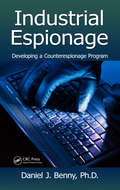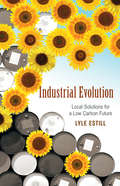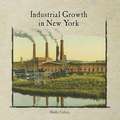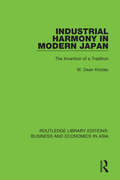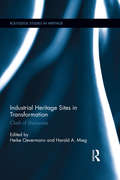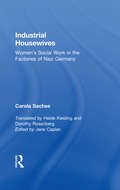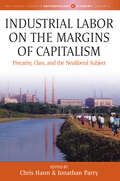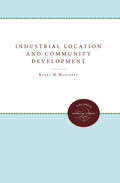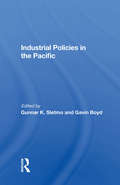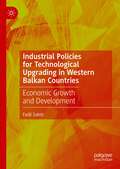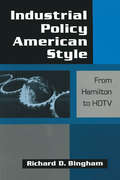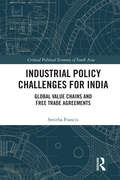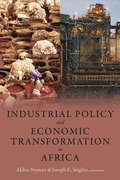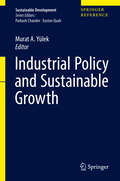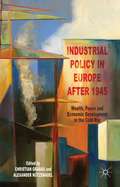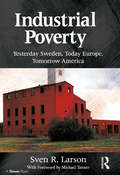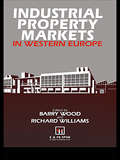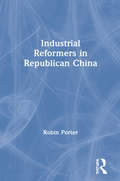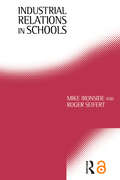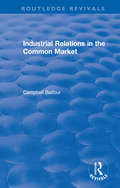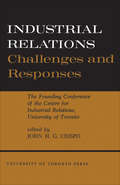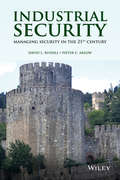- Table View
- List View
Industrial Espionage: Developing a Counterespionage Program
by Daniel J. BennyThe FBI estimates that billions of U.S. dollars are lost each year to foreign and domestic competitors who deliberately target industrial trade secrets. And, although today‘s organizations face unprecedented threats to the security of their proprietary information and assets, most books on industrial espionage fail to supply guidelines for establis
Industrial Evolution
by Lyle EstillIn Small is Possible Lyle Estill introduced the compelling story of the creation of a strong local economy by several committed entrepreneurs. Industrial Evolution shows how these same entrepreneurs kept their local economy alive in the face of economic downturn and uncertain times, emerging with a model of how industry might adapt and thrive in a post carbon future.
Industrial Growth in New York
by Holly CefreyA book about the growth of industries in New York City.
Industrial Harmony in Modern Japan: The Invention of a Tradition (Routledge Library Editions: Business and Economics in Asia #17)
by W. Dean KinzleyEconomic success in Japan has been attributed to the existence of harmonious labour-management relations. This book, first published in 1991, argues that this unique ‘culture of harmony’ was consciously invented and developed over the last century. A semi-bureaucratic organization called the Kyochokai was established in 1919 to meet the needs of an emerging industrial society. It took the lead in trying to define the values which would be suitable for a new Japanese-style industrial culture. The resulting ‘invented’ tradition has played an important role in the evolution and character of Japanese economic values and behaviour.
Industrial Heritage Sites in Transformation: Clash of Discourses (Routledge Studies In Heritage Ser.)
by Harald A. Mieg Heike OevermannThe management of industrial heritage sites requires rethinking in the context of urban change, and the issue of how to balance protection, preservation/conservation, and development becomes all the more crucial as industrial heritage sites grow in number. This brings into play new challenges—not only through the known conflicts between monument preservation and contemporary architecture, but also with the increasing demand for economic urban development by reusing the built heritage of former industrial sites. This book explores the conservation and change of industrial heritage sites in transformation, presenting and examining ten European and Asian case studies. The interdisciplinary approach of the book connects a diversity of rationales and discourses, including monument protection, World Heritage conventions, urban regeneration, urban planning and design, architecture, and politics. This is the first book to deepen the understanding of industrial heritage site management as a networked, multi-dimensional task involving diverse social agents and societal discourses.
Industrial Housewives: Women's Social Work in the Factories of Nazi Germany
by Carola SachseFocusing on women and their work, this valuable historical study traces industrial social work from its inception through the Nazi period. Author Sachse provides an analysis of policies applied to women workers rather than developed by and for them--as an example of how social policy treats women. This thorough book examines the continuities and discontinuities of industrial social work, and assesses the effect on the industrial welfare system of developments within National Socialism. Within this framework the study examines the role of women in industrial social work and labor relations, the attitudes of various groups toward the proper relations between industry and government, and the well-documented relationship between industrialists and the German Labor Front (DAF), the organization that replaced the outlawed labor unions.
Industrial Labor on the Margins of Capitalism: Precarity, Class, and the Neoliberal Subject (Max Planck Studies in Anthropology and Economy #4)
by Jonathan Parry Chris HannBringing together ethnographic case studies of industrial labor from different parts of the world, Industrial Labor on the Margins of Capitalism explores the increasing casualization of workforces and the weakening power of organized labor. This division owes much to state policies and is reflected in local understandings of class. By exploring this relationship, these essays question the claim that neoliberal ideology has become the new ‘commonsense’ of our times and suggest various propositions about the conditions that create employment regimes based on flexible labor.
Industrial Location and Community Development
by Barry M. MoriartyThis study describes and explains the concepts, materials, and methods designed to make community industrial development programs more effective. It attempts to reconcile the three different--and often conflicting--interest groups involved: the industrial land user, represented by the manufacturer seraching for a location; the landowner, represented by the industrial or economic developer; and the community, represented by the planner and other government officials.Originally published in 1980.A UNC Press Enduring Edition -- UNC Press Enduring Editions use the latest in digital technology to make available again books from our distinguished backlist that were previously out of print. These editions are published unaltered from the original, and are presented in affordable paperback formats, bringing readers both historical and cultural value.
Industrial Policies In The Pacific
by Gunnar K. Sletmo Gavin BoydIn GATT negotiations over the past several years the United States, a founding member of the Asia Pacific Economic Cooperation Forum, has been pushing hard for a global liberalization of trade in services. This development would have special significance for the Pacific because of the intensifying competition between the United States and Japan for market shares. A comprehensive analysis of the service sector's role in that dynamic region is offered in this timely volume. Leading experts explore how service enterprises have affected trade in goods and transnational manufacturing, forming a regional pattern of interdependence. The authors assess each service sector from a regional perspective and offer detailed individual country studies as well. The concluding chapters provide a broad overview of corporate strategies, discuss questions of regional cooperation, and identify opportunities for new regional service enterprises.
Industrial Policies for Technological Upgrading in Western Balkan Countries: Economic Growth and Development
by Fadil SahitiThis book focuses on Albania, North Macedonia and Kosovo; it explores the industrial policies currently in place in these economies and compares their effects with the situation in Slovenia, which is used as a reference country. It provides a brief introduction to some new industrial policy approaches and proposes a new industrial policy framework that focuses on development of the national innovation system through technology upgrading and increased exploitation of technology to build the foundations for sustainable development. Finally, it provides an empirical analysis of the technological capabilities of the manufacturing firms operating in in Albania, North Macedonia and Kosovo.It delves into the technical-economic properties of these Western Balkans countries and identifies some strategic options for industrial policy. It emphasizes the need for a form of governance that emphasizes on industrial development and innovation capabilities, which are required for the implementation of these new industrial policies. The analysis draws on the current industrial policy literature and work on developing (catch-up) economies, technological upgrading and innovation studies, which represent current academic thinking in these fields.
Industrial Policy American-style: From Hamilton to HDTV
by Richard D. BinghamThe proper role of government in the US economy has long been the subject of ideological dispute. This study of industrial policy as practised by administration after administration, explores the variations from a hands-off approach to protectionist policies and aggressive support for businesses.
Industrial Policy Challenges for India: Global Value Chains and Free Trade Agreements (Critical Political Economy of South Asia)
by Smitha FrancisThis book looks at the debates on global value chains (GVCs) and free trade agreements (FTAs) as springboards for industrial development in developing countries, especially India. It connects the outcomes in GVC-led industrial restructuring and upgrading to industrial policy choices in trade and FDI liberalisation, in particular those through FTAs. With the share of manufacturing in GDP stagnant at around 15–16% since the 1980s, India’s policymakers have pinned their hopes on greater integration into GVCs to revitalise the manufacturing sector. The multiple FTAs the country has signed over the last few years, specifically the ones with the Association of Southeast Asian Nations (ASEAN), South Korea, Malaysia and Japan have been sought to be rationalised using the same argument. The book argues that failing to factor in the industrial policy causalities involved in sustainable indigenous technology development, structural barriers to the entry into GVCs, the assessments of the available evidence on the adverse impact of trade and FDI liberalisation as well as existing FTAs on firm-level incentives for undertaking domestic production, and the industrial policy constraints imposed by FTAs can prove costly for the trajectories of developing country economies, including India. Rich in data, this book will be useful to scholars and researchers of development economics, economics in general, development studies and public policy as well as government bodies, industry experts and policymakers.
Industrial Policy and Economic Transformation in Africa
by Joseph E. Stiglitz Akbar NomanThe revival of economic growth in Sub-Saharan Africa is all the more welcome for having followed one of the worst economic disasters since the industrial revolution. Six of the world's fastest growing economies in the 2000s were African. But with the exception of Ethiopia and Rwanda, the growth of these African nations was largely fueled by discoveries and the rising price of oil. Deindustrialization has yet to be reversed and structural transformation remains limited. This book explores the vital role that industrial policies can play in bringing about a transformation of African economies. Such policies pertain not just to industry. They traverse all economic sectors, including finance, information technology, and agriculture. More accurately understood as a package of learning, industrial, and technology (LIT) policies, they aim to bring vigorous and lasting growth to the region. This collection features case studies of LIT policies in action in many parts of the world, examining their risks and rewards and what they mean for Sub-Saharan Africa.
Industrial Policy and Economic Transformation in Africa (Initiative for Policy Dialogue at Columbia: Challenges in Development and Globalization)
by Stiglitz Joseph E. Noman AkbarThe revival of economic growth in Sub-Saharan Africa is all the more welcome for having followed one of the worst economic disasters—a quarter century of economic malaise for most of the region—since the industrial revolution. Six of the world's fastest-growing economies in the first decade of this century were African. Yet only in Ethiopia and Rwanda was growth not based on resources and the rising price of oil. Deindustrialization has yet to be reversed, and progress toward creating a modern economy remains limited.This book explores the vital role that active government policies can play in transforming African economies. Such policies pertain not just to industry. They traverse all economic sectors, including finance, information technology, and agriculture. These packages of learning, industrial, and technology (LIT) policies aim to bring vigorous and lasting growth to the region. This collection features case studies of LIT policies in action in many parts of the world, examining their risks and rewards and what they mean for Sub-Saharan Africa.
Industrial Policy and Sustainable Growth
by Murat A. YülekThis volume looks at the critical issues of industrial policy and sustainability. It assesses the gap between how developed and developing countries have integrated sustainability issues in their industrial policies, and how they should have ideally done so. The book looks at the specific issues of middle income trap, levels of industrialization and the distribution of manufacturing activities among nations, and presents analysis of sector and country specific policy case studies in areas such as health, energy, medical devices, aviation, automobile manufacturing. The volume also examines trade policies and their impact on industry and environment, and elaborate on how industrial policies involve selective direct and indirect sectoral policies which play a role in assisting policy makers manage objectives of catch up and sustainability.
Industrial Policy in Europe after 1945
by Alexander Nützenadel Christian GrabasBringing together renowned scholars in the field with younger researchers, this interdisciplinary study of the history of post-war industrial policy in Europe investigates transfers across borders and locates industrial policy in the context of the Cold War from a global perspective.
Industrial Policy: USA and UK Debates (Routledge Revivals)
by Grahame ThompsonWith the advent of Thatcherism in the UK and Reaganomics in the USA, ‘industrial policy’ had become something of a discredited notion in the 1980s. The emphasis had shifted to programmes of deregulation, de-nationalization, and tax reform. The essays in this challenging and vigorous collection, first published in 1989, sprung from work that had been conducted in the USA, notably at the Harvard Business School, on reappraising the role of the public sector in industrial management. This American work suggested ways in which public sector and other bodies might have revitalized industrial life. This book is ideal for students of business and economics.
Industrial Poverty: Yesterday Sweden, Today Europe, Tomorrow America
by Sven R. LarsonConventional wisdom says that Europe’s crisis is a financial crisis. But is this really the case? In Industrial Poverty, economist Sven R. Larson, challenges this view and suggests instead that Europe is in a state of permanent economic decline. The crisis, says Larson, is in fact a welfare-state crisis. Over decades, government has grown too big for the private sector to pay for; when the recession hit in 2008 most European economies could no longer bear the burden of the welfare state. Raging deficits, accelerating unemployment and harsh austerity policies hurled the continent into more than a regular recession. Europe is entering a new economic state: industrial poverty. Using Sweden in the 1990s as an example, Larson shows how a welfare-state crisis combined with the wrong kind of austerity policies replaces prosperity with industrial poverty. In a desperate effort to balance the budget and save the welfare state in the midst of the crisis, the Swedish government subjected the country to some of the toughest austerity measures on record. The outcome was a permanent reduction in the standard of living for Swedish families as well as the standard of government services. Today, Europe is going through the same transition into industrial poverty. Tomorrow, it could be the United States, unless Congress and the President take decisive action against the runaway budget deficit.
Industrial Property Markets in Western Europe
by Richard Williams Barry WoodAn important reference book both now and post 1992. It gives a clear introduction to the industrial property market in Europe and provides the information needed to understand each country's system of planning and property development.
Industrial Reformers in Republican China (Studies On Modern China)
by Robin PorterThis is the story of a dedicated group of foreign and Chinese reformers who tried, but failed, to solve China's intractable industrial problems over the three decades prior to 1949. It explores the complex rivalries of Chinese and foreigners against a backdrop of extreme nationalism.
Industrial Relations in Japan: The Peripheral Sector (Nissan Institute/Routledge Japanese Studies)
by Norma ChalmersThe conventional picture of industry and industrial relations in Japan is of a number of very large firms providing extremely attractive working conditions for their happy and contented workforce. Norma Chalmers shows that there is in fact another, very different side to the picture, which occurs in the the peripheral sector. Here, conditions are often poor, wages very low and continuity of employment virtually non-existent. There are many small firms where the effectiveness of worker organisation and bargaining declines as the firm's size and proximity to the industrial centre decrease. Moreover, as Chalmers shows, the peripheral sector is very large, and the conventional picture of the model workforce should probably be confined to a few flagship companies. The book argues that the model nature of the large firms may stem in part from the fact that they are able to off-load problems onto smaller firms who produce the components necessary for the large firm sector at disadvantageous subcontract terms.
Industrial Relations in Schools
by Mike Ironside Roger SeifertThe subject of industrial relations is intimately connected with the nature of schooling - in particular, the teacher trade unions have played and will continue to play a crucial role in shaping the school system - yet this subject has been virtually neglected in educational literature. Mike Ironside and Roger Seifert's book redresses this balance and unravels the complex issues surrounding the employment and management of teachers. Recent changes in education have had massive implications for the way in which our education system is organised. In the light of recent events, this book questions who controls or ought to control schools, focusing on the government, Department of Education, LEA's, head teachers, school governors, parents and teaching unions. The authors argue that in order for schools to continue to function, industrial relations must be given priority, including the development of a proper framework for negotiation and the resolution of conflicts.
Industrial Relations in the Common Market (Routledge Revivals)
by Campbell BalfourOriginally published in 1972, Industrial Relations in the Common Market is a comparative study of the members of the Common Market, exploring the range of industrial relations and some of the contemporary issues and problems that they faced. The book provides a comprehensive description of the Common Market, its economic growth and the diverse economies of the member countries. It also examines political parties and trade unions, and deals with the themes of collective bargaining, incomes policy, law and labour relations, industrial democracy, labour mobility and social security. Industrial Relations in the Common Market is an excellent insight into the history of industrial relations within this economic community.
Industrial Relations: The Founding Conference of the Centre for Industrial Relations, University of Toronto
by John H. CrispoIndustrial relations, which in the past have focused almost entirely on union-management relations, have recently been expanded to include such new areas of interest as manpower and poverty problems. At the University of Toronto a new Centre for Industrial Relations has been established, a research-oriented institution whose primary objective is to further scholarly investigations into all phases of industrial relations. To launch the new Centre a conference was held with distinguished Canadian and international authorities invited to discuss the challenges and responses for Industrial Relations in the next decade, from various points of view. This volume, based on the papers presented, will be a welcome contribution to knowledge in this challenging field.<P><P> In Part I, "An International Perspective," David A. Morse considers the conference's general theme in terms of its world-wide ramifications. Part II, "Collective Bargaining in an Age of Change," is devoted mainly to a discussion of the impact of industrial change on collective-bargaining institutions and practices. James R. Bright begins with a reminder that there are two schools of thought about the effect of automation upon such variables as skill and wage differentials. Then Frederick Harbison and Arnold R. Weber assess the recent record of collective bargaining: Professor Harbison provides a wide-ranging analysis of the performance of the American collective-bargaining system to date, and Professor Weber describes the effect of technological change upon the respective power of union and management, upon negotiating procedures, and upon the substantive results of collective bargaining. Harry W. Arthurs explores the role of law in coping with change, especially the technological variety. The third part of the volume, "On the Frontier of Industrial Relations," considers two of the many new industrial relations problems: Wilbert E. Moore, discussing the individual in an organizational society, asks for a reconsideration of the roles of institutional responses to the challenges posed by industrialization. Finally, there are two discussions devoted to one of the most pressing economic and social problems: poverty. The Honourable Maurice Sauvé, who, as Canada's Minister of Forestry, is in charge of the Agriculture Rehabilitation and Development Act, discusses the earnest response of governments to the challenge of poverty; Tom Cosgrove, discussing the United States "war on poverty," reviews the dimensions of the challenge posed by poverty in the United States and outlines the federal legislative response to date.<P> These provocative contributions should be received with great interest by representatives of labour, management, and government, as well as by those members of the public who are concerned with the problems of a growing industrial society.
Industrial Security
by David L. Russell Pieter C. ArlowA comprehensive and practical guide to security organization and planning in industrial plants Features Basic definitions related to plant security Features Countermeasures and response methods Features Facilities and equipment, and security organization Topics covered are applicable to multiple types of industrial plants Illustrates practical techniques for assessing and evaluating financial and corporate risks
